Menu
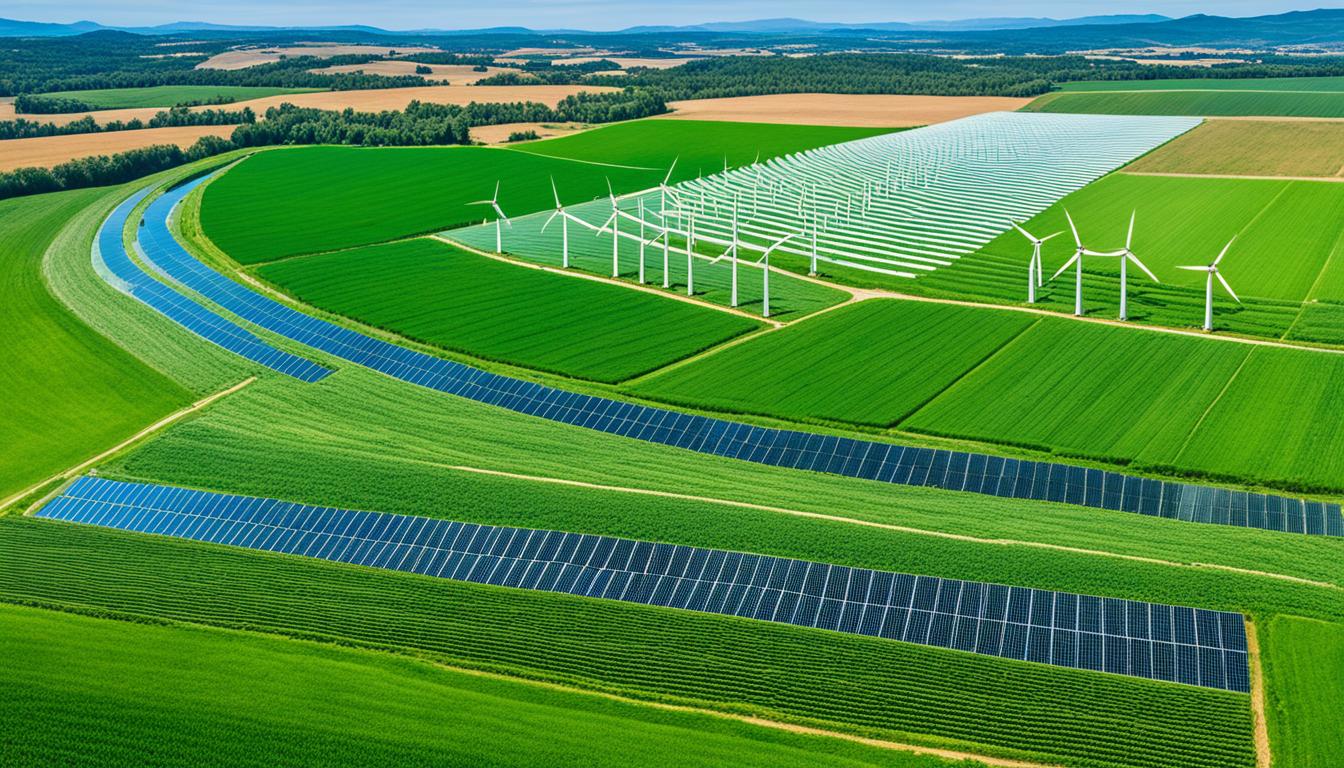
Did you know hitting a 3% soil organic matter level is best for soil health? Yet, it’s tough in places like Georgia, especially on sandy soils. This shows how vital sustainable organic farming is for keeping soil healthy and the environment in balance.
Organic farming is all about eco-friendly ways, like using cover crops to recycle nutrients. Smaller veggie farmers don’t just grow plants. They also plan what to grow where, making sure not to use the same spot for a plant’s family for about eight years. This way, they foster healthy soil and wildlife, which is key to farming that last long and doesn’t harm the planet.
When farmers are certified organic, they must follow strict rules. Only special, organic seeds can be used. They mustn’t use GMO seeds. Also, they’re off synthetic fertilizers. Instead, they pick from options like those coming from animals, plants, or minerals. And to deal with pests, they have clever ways that don’t rely on harmful chemicals. They use friendly bugs, natural substances, things like nets to block pests, and traditional ways of keeping pests off without hurting the environment.
Organic farms are also careful about where they are and how they store things. They must have areas around their fields that are just for protection. These protect the farm from pollution. Besides, they must follow very detailed guidelines on how to handle and store food. Even though organic farming might not produce as much food as the usual way, people are buying organic food more and more. It’s because they want to support ways of farming that are kind to the Earth.
Sustainable organic farming looks at the big picture. It balances the health of the environment, making money, and being fair to all. This way of farming looks after needs today without harming what those in the future must have.
Sustainability in farming means using nature wisely to meet our needs now and in the future. It involves eco-friendly practices like creating buffer zones to stop chemicals from running off, not tilling the soil, and using natural ways to grow plants. These methods help the soil and life on the farm stay healthy.
Organic farming follows nature’s lead to grow food and products. It avoids man-made pesticides and fertilisers. Instead, it uses natural ways to protect crops and the land. This farming method is good for the planet, works well, and encourages the use of special organic seeds.
The US has an Organic Program that checks and approves farms that follow these special rules. Even though at first it can be tough to switch to organic, these farms get paid more for their products. They also get to sell in new places and may get help with funding. For example, in California, farms must get approval from a trusted third party to say they’re truly organic.
Places like the Center for Agroecology and Sustainable Food Systems at UC Santa Cruz, and others show support for farming that’s kind to the environment. These groups teach and work on doing farming in a way that’s good all around. They focus on practical learning about lasting food systems to help move farming in a green direction.
Sustainability in farming is vital for our future, most notably because our planet is getting more crowded. By 2050, nearly eight billion people will live here. This means we must produce 70% more food to feed everyone.
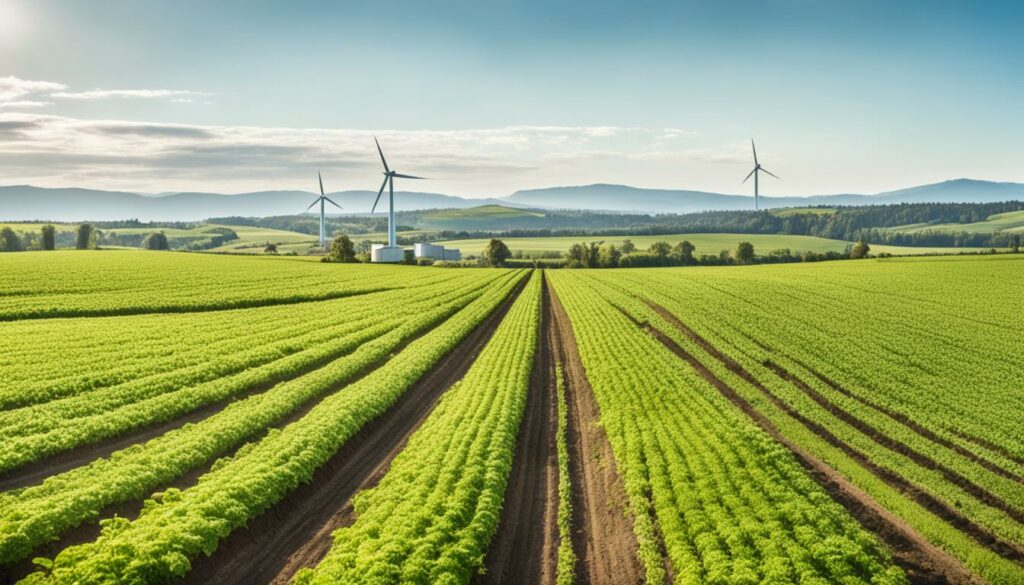
Sustainable farming focuses on being kinder to the planet. It uses methods like organic farming that save water and protect wildlife. Such methods also cut down on harmful waste. By using natural ways to grow food, the land stays healthy for the long term. Organic farming is also great for trapping harmful carbon and fighting climate change.
Sustainable farming doesn’t just help the planet. It helps around one billion people who earn their living from farming. It tries to increase food without harming the environment. This makes life better for people and animals. It also boosts local economies and helps small farmers succeed. They can make more food with less damage to the earth.
Both big and small farms can use sustainable ways to produce food. This can mean doing more organic farming or using fewer chemicals. It can also involve using clean energy. The trend towards things like growing food in cities and eating more plant foods shows how farming is changing for the better.
“Alternative food options, including urban farming and plant-based diets, are crucial in reducing reliance on traditional farming methods and promoting sustainability.”
This statement shows that choosing plant foods over meat can cut down on harmful gases by 73%. This eco-friendly choice helps both the planet and people. It makes our food supply safer and stronger.
Now, let’s look back at some key moments in making farming more sustainable:
| Year | Event |
|---|---|
| 1996 | Vegan Organic Network founded in London |
| 2007 | Stockfree Organic Standards codified in the United Kingdom |
| 2008 | Veganic Agriculture Network founded in the United States |
| 2017 | Biocyclic Vegan Standards codified in Germany |
In wrapping up, sustainable farming not only helps our world but leads us to a bright future. It boosts nature, saves water, and improves local areas. Choosing to farm sustainably is a smart step towards a healthier, wealthier planet.
Rotating crops and growing many kinds is key to farming well. Using organic ways like mixing crops and changing what’s grown each year helps the earth. It makes the soil better by 20% and supports farming that’s good for the planet.
Changing crops helps the land in many ways. It makes soil richer and helps stop pests. By planting different things each year, we make the land better. We’ve seen that growing various crops together increases corn by 28%.
tThis way, we need less water during dry years. It makes farming more stable over time.
Growing crops together and alternating them yearly makes the most of the land. Mixing crops helps fight weeds and pests. It naturally makes the soil healthier too.
By changing what’s planted every year, the land stays healthier. It means less soil runs off, and we need fewer chemicals. These methods aren’t just good for nature. They also help farmers do well, following the beliefs of organic farming.
The following table presents a summary of key benefits derived from various crop rotation and diversity practices:
| Practice | Environmental Benefits | Economic Benefits |
|---|---|---|
| Crop Rotation |
|
|
| Intercropping |
|
|
| Multiyear Rotations |
|
|
Planting cover crops is crucial for keeping soil healthy in farms. These crops, like clover and rye, have multiple benefits. Cover crops stop soil erosion and help soil keep its nutrients. They also control weeds without chemicals, making farming stronger and more natural.
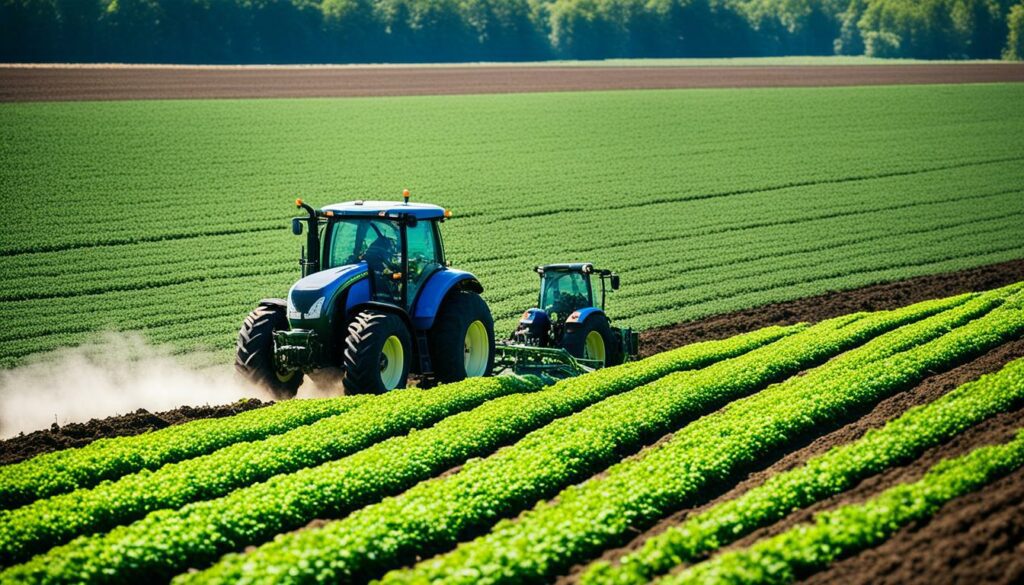
Using cover crops and perennials has many pluses. For instance, vineyards use cover crops between vines for better drainage. This method is great for soil health and keeps moisture well. Red clover and berseem clover are popular picks for this.
In rich soil areas, perennials do very well. They are great for long-lasting soil health. Some growers choose plants that seed themselves to save money on buying seeds every year.
Cover crops help keep the soil warm at night, reducing frost risks. They can, however, make plants grow less strong, which might be good or bad. Managing them well is key to success.
Picking the right cover crops means thinking about the local weather and farm setup. Plants that like shade are good for orchards. They do well even with different sunlight levels.
Cover cropping happens between planting money-making crops. It’s an important step to keep soil in top shape and reduce waste. Research, like from the University of Florida, shows these crops provide a lot of material, proving their worth in farming health.
Choosing when and what to plant is crucial for cover crops. It’s about understanding what works best for the land. This includes knowing about the weather and how much work you can do. Doing it right means better soil and growth on the farm.
Switching to less or no tillage helps the soil last longer. It keeps the ground strong and full of life.
No-till farming is all about planting seeds straight into the ground. Organic farmers love it. They use a roller crimper to cut cover crops and make a protective blanket over the soil. This method stops weeds and supports the growth of new crops. Good crops for this method are crimson clover, winter rye, spring oats, and fava beans.
No-till does more than get rid of weeds. It also stops the soil from washing away, keeps it healthy, and needs less work to keep up. This way of farming helps more plants and animals live in the fields. It also holds onto water better, which is great for the environment.
Reduced tilling just scratches the top layer of soil, keeping it in good shape. This lets the soil stay healthy without turning it all over. Farmers use methods like mulch tillage to help keep the ground covered. This is good for the soil and helps hold onto water better.
In the USA, more farmers started using less tillage from 2012 to 2017. The number went up from 24% to 31%. This shows that farmers see the good side of giving the soil a softer touch. It saves them money and time, helps more plants and animals live there, and cuts down on weeds.
The idea of Integrated Pest Management (IPM) started in the 1970s. This was a response to too many pesticides being used. IPM aims to protect crops without using dangerous chemicals, making farming more sustainable.
Biointensive IPM takes IPM a step further. It uses living things and natural systems to control pests. Organic farmers must use these methods, which are good for the earth and stop pests without harming nature. This is a rule under the USDA National Organic Program (NOP).
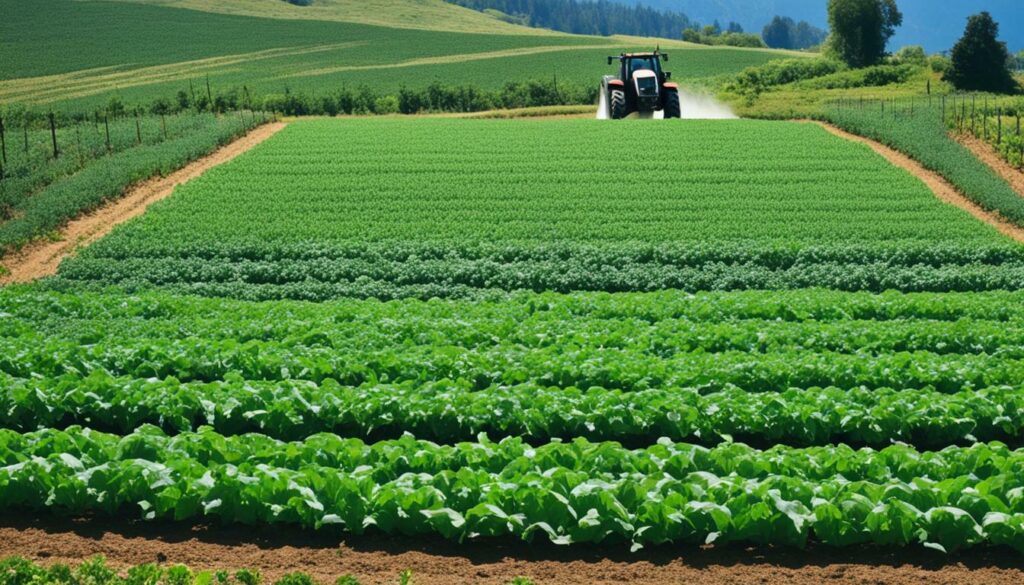
IPM not only relies on nature. It also uses machines, special farming ways, and only a little bit of chemicals. For example, they might use traps or pick crop varieties that are naturally pest-resistant. This is called Integrated Weed Management (IWM). IWM helps fight the problems herbicides bring, such as weed resistance and health dangers.
Weed control is super important, especially right at the start of a crop’s life. But, there are challenges to doing this the IPM way. Farmers worry about these methods sometimes, and they don’t always get enough help from the government or big farm businesses.
IPM does more than stop pests and weeds:
IPM supports using plants that pests don’t like and smarter ways to plant crops. It also uses certain plants to attract pests away from the main crop, acting like a natural shield. This is a clever way to fight pests without hurting the environment.
IPM also uses the right times to plant to avoid pests. Since weeds cause a lot of damage, managing them is really important. Methods like picking weeds by hand, using cover crops, and barriers help a lot.
In short, integrated pest management is a full, long-term answer to pest problems. It’s better than just using chemicals. IPM helps keep the earth safe while growing healthy food. This makes it a key part of sustainable agriculture.
Bringing together livestock and crops is key to regenerative farming. It boosts the economy and helps the environment. It matches well because plants and animals help each other. This leads to better soil, less waste, and healthier farming.
Studies from Iowa State University and others show the good sides of mixing crops and animals. For four years, they looked at two ways of growing things. One way included crops in a certain order, then animals. The other used different crops and animals. They found that the second way made the soil and nutrients better.
People seem to like beef from cattle that eat winter wheat more than those that eat winter rye. Also, cows that are a mix of Jersey, Normande, and Viking Red like to eat green crops and vegetables rather than Holsteins. These mixed cattle have better meat and fats for our health.
Learning about this is free thanks to a course at Iowa State University. It’s called “Organic Agriculture, Theory & Practice.” The course has a part about mixing animals and plants. Other studies agree that having cows eat certain greens in winter is good. It proves we’re on the right track.
| Farm | Practices | Certification Year |
|---|---|---|
| Shady Side Farm, MI | Grazing & terminating cover crop, breaking up pasture for crops | 2010 |
| Hidden Hollow Farm, VA | Grazing & terminating cover crop, breaking up pasture, clipping hay pastures, on-farm compost | 2006 |
| Frog Song Organics, FL | Grazing & terminating cover crop, cleaning up crop residue, breaking pest cycles | 2012 |
Mixing crops and animals also lowers environmental impact and makes farming tougher. There’s money to be saved, too. For example, the waste from 100 milking cows is worth about $20,000 a year. This shows how good farming can be for the pocket and the planet.
Even though mixing both needs attention to rules and farm changes, it’s worth it. It helps farms be more sustainable and make money. By using animals and plants together, farms help the environment. They show that farming can be both friendly and successful.
Agroforestry combines trees and shrubs in farming, creating sustainable systems. This approach helps meet food demands, especially in Africa. Here, rapid growth strains farms and increases chemical use.
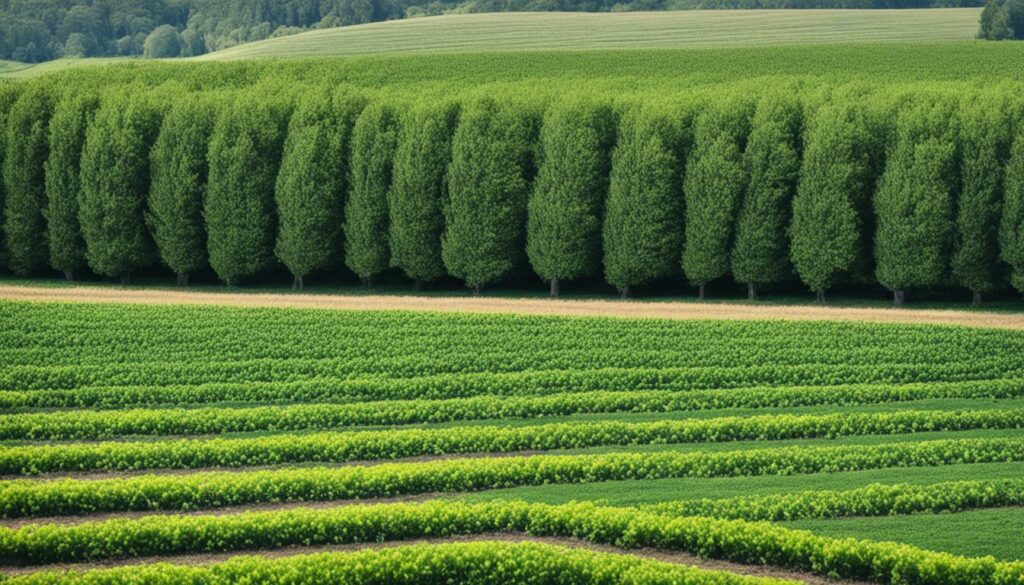
By mixing trees with farming, we get more than food. We also have firewood, animal food, and valuable resources. This method improves local climate and economy. It also creates jobs, making it key for farming’s future.
Agroforestry stops soil erosion with trees as windbreaks. This keeps the soil healthy, boosts crop growth and encourages eco-friendly farming. It also helps the environment by adding plants and animals, making communities better off.
Organic farming and agroforestry together are great for nature. They make soil richer and healthier, supporting good farming without harm. They also protect farms and houses from bad weather, keeping people and their things safe.
The USDA strongly supports agroforestry. Its work shows the big benefits of these methods. Now, the USDA is pushing these techniques more, setting the path for better farming across the USA. These methods aim to help in many ways, like by creating jobs and fighting climate change.
Agroforestry is huge in both Europe and the tropics, covering lots of land. Its popularity shows it’s a key part of sustainable farming. By mixing trees with farming, we get more food, money, and a healthier world for plants and animals.
Taking a full view on how to manage landscapes is key in sustainable farming. It combines farming areas with wild parts. By doing this, it boosts biodiversity. This makes the land healthier for farming.
Looking at landscapes as a whole helps with sustainable farming. It means carefully planning to keep both farming and wildlife areas healthy. By using organic methods, farms can produce well while helping the environment.
Placing cover crops and using techniques to disturb the soil less improves the land. These methods help soil to keep water better.
When farms grow many different crops, they have fewer pests and bigger harvests. They see a 20% cut in pest harm and a 15% rise in what they harvest. Adding animals to the mix makes farms 30% more efficient and 10% more profitable.
These findings show how vital it is to connect cultivated and wild areas. Sustainable farms that follow these landscape rules are better at making soil and water better. They also help fight climate change by releasing fewer greenhouse gases.
Organic farming follows the USDA Organic Standards. These standards require using natural methods. They are about being good for the earth and for people too. Organic farms work in ways that don’t harm the environment. They help keep the soil rich, support different plants and animals, and keep nature healthy.
Organic farmers follow strict rules. They can’t use some materials on their land for three years before planting. This rule makes sure the soil is clean from chemicals. Farmers make the soil better by using compost and other natural things. This helps the soil be healthy without using bad stuff.
Farmers must use organic seeds if they can. But if they can’t find them, they can use others that are not changed in a lab. Animals on organic farms must have lots of space outside. They need to eat food that is also organic. No fake hormones or bad chemicals are allowed.
Getting certified as an organic farmer is tough. Farmers have to prove they follow all the rules. They need to show they use the right seeds and treat their animals well. They also can’t use or add dangerous stuff to their farm products.
Food processors that make organic food also have to be careful. They can’t mix organic food with non-organic food and have to keep their machines clean. This helps make sure the food stays good for the environment and for people.
| Aspect | USDA Organic Requirement |
|---|---|
| Prohibited Materials | Cannot be applied for 36 months prior to harvest |
| Seed Usage | Conventional seeds can be used if organic ones are unavailable; must not be GMO |
| Livestock Conditions | Access to outdoor areas, organic feed, and no synthetic additives |
| Processing | Prevent commingling, ensure no contact with prohibited substances |
Following these rules makes organic farming special. It values taking care of nature and people. The hard work in getting certified shows the dedication to making food the best way possible without using bad things.
Renewable energy in farming is key for greener and independent farms. The Rural Energy for America Program (REAP) is a big help. It offers grants that cover half the costs. It lets farms combine grants with loans for up to 75% funding. This boost came with the Inflation Reduction Act.
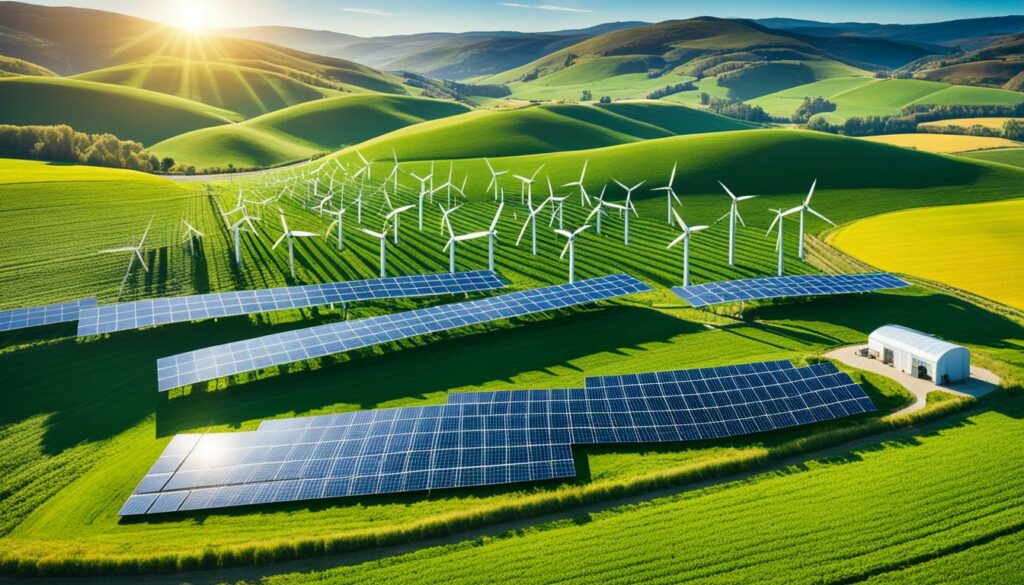
The Investment Tax Credit (ITC) is another way to support green energy. It cuts federal taxes by 30% if you install a solar system. The USDA also backs farms making and using biofuels well.
States also help. They offer the Agriculture Energy Efficiency Rebate Program. This gives money back for green projects. There’s also support for small businesses upgrading for greener practices.
Using more biomass for energy could earn $20 billion for farmers and cut emissions. Wind energy could also create 80,000 jobs and $1.2 billion for landowners by 2020, as per the U.S. Department of Energy.
“Renewable energy in farming is essential for our future. The many support programs show its importance.”
Thinking of using renewable energy? Apply for net metering as soon as you can. It can cut your costs and make green energy more affordable for farms.
Keeping the balance in organic farming means using natural pest control methods. These help by using fewer chemicals but still managing pests. By knowing the life cycles of pests, we can create effective and sustainable control plans.
One way to fight pests is by using their natural enemies. This includes insects like Lacewings, Ladybeetles, Hoverflies, and parasitic wasps. They like plants such as Fern-leaf yarrow, which gives them a good home and food.
The Biological Control of Insects and Mites booklet, 1.34 MB, gives lots of info on these methods. It helps fight pests naturally, which keeps the farm’s ecosystem diverse and healthy.
Using physical devices to control pests is important too. This can be traps, barriers, or covers. Row covers, for example, keep insects off young plants. Traps can help reduce pest numbers.
The Resource Guide for Organic Insect and Disease Management, 11.16 MB, has detailed info on these methods. It shows how using these practices means using fewer synthetic chemicals, which is good for organic farming.
Ways like managing soil health, planting certain things together, and changing where crops grow are also helpful. They work together with the other methods to create a natural and balanced pest control system.
| Resource | Description | File Size |
|---|---|---|
| Biological Control of Insects and Mites | A guide on biological control techniques to manage pest populations naturally. | 1.34 MB |
| Resource Guide for Organic Insect and Disease Management | Detailed instructions on applying various natural pest management methods. | 11.16 MB |
| Predatory Mites for Organic Thrips Control in High Tunnel Cucumbers | Research presentation on using predatory mites for targeted pest control. | 21.33 MB |
Hydroponics and aquaponics bring big change in how we do farming sustainably. They help farmers use space and resources better. This is key for making farming greener and more innovative.
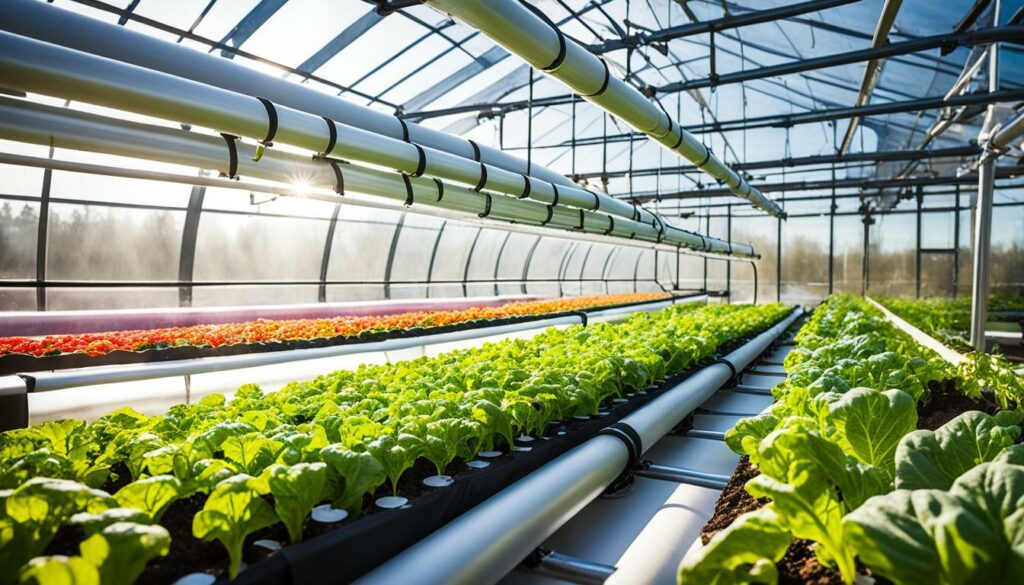
Hydroponics is great for growing food and flowers without soil. It saves a lot of water and uses less nutrients efficiently. The water that carries the nutrients needs to be just right, between pH 5.5 and 6.5, for plants to grow their best.
Aquaponics combines growing plants with raising fish. It’s a smart way to farm for the future. The water that fish live in is used to feed the plants. Fish poop is turned into food for plants by helpful bacteria. This way, fish and plants help each other grow.
Both hydroponics and aquaponics have special ways to help plants grow well. They use methods like NFT and DWC. Hydroponics doesn’t need a lot of energy, which makes it good for the planet. These methods show how farming can be better for the environment.
By using hydroponics and aquaponics, we save water and stop too many nutrients from getting into the water. Farming becomes a way to make food without harming the planet.
Polycultures and permaculture design are key in sustainable farming. They focus on natural harmony. By growing various plants together, farmers raise their yields by up to 80%. This is more than what’s seen in monoculture farming, where only one type of plant is grown. The use of synthetic chemicals is also reduced.
These methods bring in a variety of insects, birds, and tiny creatures. They naturally control pests, making the area less attractive to harmful bugs. This cuts down on the need for chemicals, which helps the soil and prevents erosion.
Permaculture and polycultures go hand-in-hand, using the same principles. Techniques like crop rotation and planting different crops together keep the soil rich and prevent it from washing away. They also help nutrients move through the ecosystem. These are great for gardens in urban areas or within communities. They help in building strong relationships and a sharing spirit.
Communities flourish when small farms embrace these methods. They improve the local economy and keep the food fresh. It’s also a way to learn from each other, which is important in facing climate change and fighting off pests together.
But, polyculture farming needs more attention and planning than growing just one crop. Farmers should pick plants that help each other and watch out for pests. They need to let nature do some of the work by attracting the insects that eat the bad ones.
| Factors | Monoculture | Polyculture |
|---|---|---|
| Yields | Standard | Up to 80% more |
| Pesticide Use | High | Reduced |
| Soil Health | Compromised | Enhanced |
| Biodiversity | Low | High |
| Labour Intensity | Lower | Higher |
Biodynamic farming is a special way of farming. It focuses on healing the land and using natural methods. Around the world, 255,051 hectares are farmed this way. It shows that this approach is making a big impact.
The heart of biodynamic farming lies in Germany, with 42% of all biodynamic land. Other countries together use about 1,750 hectares each. This big difference highlights Germany’s significant role in spreading this farming method.
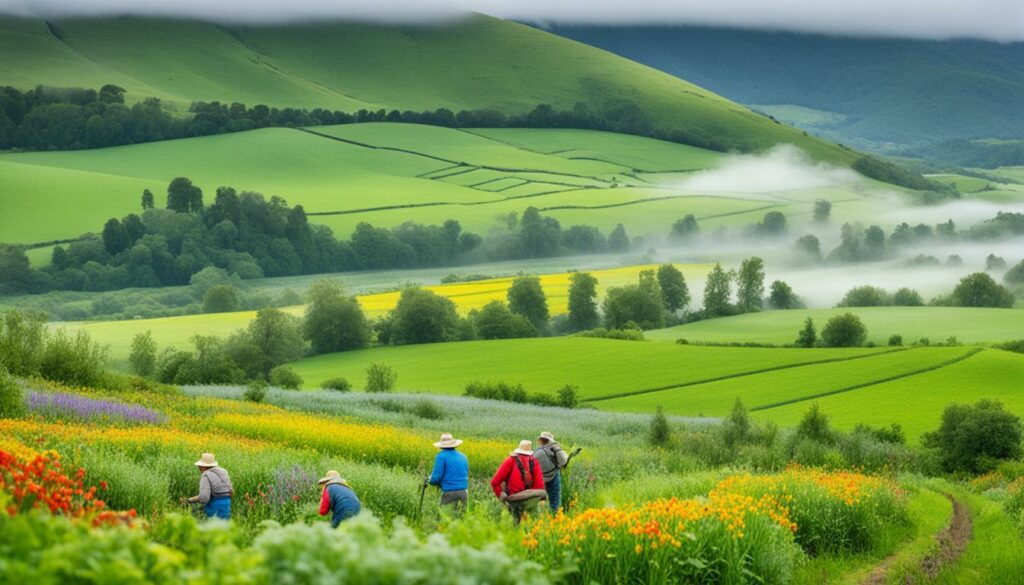
In the United States, biodynamic farming has been around since 1926. A group called the Biodynamic Farming & Gardening Association started in 1938 to help farmers. Great Britain also joined in 1927, setting up the Biodynamic Agriculture Association in 1928.
In Australia, biodynamic farming started with Ernesto Genoni in 1928. He opened Victoria’s first farm by 1933. Later, in 1989, Biodynamic Agriculture Australia was created to support biodynamic farming.
Biodynamic farming is more than just organic farming. It includes the study of the universe’s cycles and specific ways to make compost. For instance, special mixtures help not only to fertilise but also to boost soil life.
| Country | Year of Introduction | Major Organisation |
|---|---|---|
| United States | 1926 | Biodynamic Farming & Gardening Association (1938) |
| Great Britain | 1927 | Biodynamic Agriculture Association (1928) |
| Australia | 1928 | Biodynamic Agriculture Australia (1989) |
| France | 1972 | International Federation of Organic Agriculture Movements |
Over 5,000 farms have been certified under the Demeter standard. They cover more than 400,000 acres in 60 countries. Farms must grow half of their animal feed and set aside 10% for wildlife. This ensures they are self-sustaining.
Special mixes like horn manure, horn silica, and horsetail tea help improve the soil and plants. They make sure farming works with the Earth’s natural rhythms. This creates a balanced environment.
Today, most of the world’s food is consumed in cities. This has led to a need for sustainable farming in urban areas to tackle food security issues and support local food systems. With more people set to live in cities – over 6.6 billion by 2050 – there is a huge push to make urban farming more innovative. This is crucial to ensure there’s enough food for everyone.
In tightly packed cities, urban farming initiatives are changing how we think about food. Take AeroFarms for example. They’ve built vertical farms close to where food is needed, cutting down the use of water by 95% when compared to traditional farming. Not only that, they’re able to produce 400 times more food in the same space each year. This saves water and uses space wisely.
In places like Phoenix, projects such as Bites are linking up urban farmers, chefs, and people who love fresh food. This creates a thriving local food community. And then there’s Gotham Greens, leading the way with high-tech greenhouses that are good for the planet. Their greenhouses use renewable energy and smart data to grow food all year round.
Technology is also changing the game for urban farming. BitGrange, for instance, helps farmers keep an eye on their crops using a smartphone. It gives them real-time data to make their farming practices better. Then there’s iFarm, with its high-tech farming solutions found all over the world. From the UAE to labs in France, it shows just how adaptable urban farming can be.
“Urban agriculture initiatives empower communities by providing jobs, skills training, and by tackling hunger and poverty issues,”
Urban farming does a lot more than just feed people. It also helps in big ways, like turning food waste into compost and collecting rainwater. These methods help cut down on pollution from rainwater runoff. Programmes like the Environmental Quality Incentives Program (EQIP) help those in urban farming with upfront money. This helps cover costs, making it easier for more people to get involved.
Supporting urban farming isn’t just about food. It also means creating jobs and getting the community involved. Farmizen is a great example, operating across India and involving a lot of people in growing food. Plus, projects like Fresh Direct’s container farms in Abuja are getting young people interested in farming sustainably. These efforts are changing the face of food production in our cities, ensuring a better food future for all.
Sustainable organic farming is the future, offering hope for agriculture. It promotes environmental health, economic sustainability, and social equity. The growing interest in organic products highlights the need to support these farming methods.
Though organic farming is a small part of the global market, it is beneficial, especially in developing areas. In these places, farmers see the value of going organic for financial and environmental gains. The adaptability of organic farming to different environmental conditions makes it a valuable choice.
Government support, through education and financial aid, is vital for organic farming’s success. Measures like research and education, and certification programs, are critical for its growth. These steps will encourage more people to adopt organic practices.
Organic farming benefits the environment greatly. Actions like composting and avoiding pesticides reduce pollution. They also lock away carbon, helping with climate change. By protecting soil and promoting biodiversity, organic farming supports a stronger food system for the future.
Sustainable organic farming is about keeping the land healthy for the long run. It mixes environmentally friendly ways with good economics and socially positive practices. This keeps the land lush without hurting our future.
It’s critical because it saves water, boosts plant and animal variety, and manages waste well. It even helps fight climate change, benefits local areas, and creates jobs. This approach cares for the planet and the people living on it.
Crop rotation does a lot of good. It makes the soil fresh, deters pests, and cuts down on chemical use. This also helps manage nutrients better and supports a wide range of plant and animal life.
Cover crops and perennials protect the soil by preventing erosion and adding nutrients back in. They fight off weeds naturally, meaning less bad chemicals are needed. This keeps the ground fertile and the environment safe.
No-till farming means planting without turning the soil over. It keeps the soil healthy by not disturbing its layers. This way, good bacteria and nutrients stay where they should. It also stops soil from washing away and keeps water in the ground.
IPM is about using many tools to control pests, like good bugs and smart farm design. It’s a way to keep things in balance without using a lot of harmful chemicals. This helps crops grow well without much harm to nature.
Mixing animals and plants helps the soil stay rich and the farm eco-system balanced. It’s good for the earth and for farmers’ businesses. This idea was developed to be a win-win for all.
Agroforestry is when you grow trees or bushes alongside crops and animals. It makes farms more diverse and productive in a sustainable way. It brings harmony to the farm and the environment around it.
It’s caring for not just the fields but the wild spaces around them too. This way, the whole area thrives with life. It’s a big-picture approach to farming that supports nature everywhere.
These standards make sure organic farms do things the natural way. They focus on keeping the soil and nature healthy. They also aim to protect people from harmful chemicals where food is grown.
To get certified, farms show they meet the USDA Organic Standards. They do this by keeping good records and letting inspectors check their farms. This proves they are really doing what they say for the environment and for us.
Farms use sunlight and wind to power their operations and cut back on pollution. They turn to these renewable sources to be kinder to the planet. It’s a modern move towards a cleaner, greener way of farming.
Instead of harsh chemicals, farms can use nature to control pests. By encouraging helpful animals and using physical barriers, they keep their fields healthy. This kind of farming is all about working hand in hand with nature.
These are ways of growing food without soil, which saves space and resources. They recycle water and nutrients efficiently. Such farming methods are smart, using as few resources as possible.
Polycultures and permaculture mimic nature’s biodiversity. They mix different crops and animals skillfully, making the farm strong and self-sustaining. They’re about making the most of what the land can naturally offer.
It’s a farming approach that works in tune with nature to enrich the land and the food it produces. It’s holistic, involving ethical farming and sustainable practices. The goal is to create farms that are truly alive and healthy from the inside out.
These are projects that bring farming into the city. They improve food supply, cut down on waste, and bring people together. These initiatives help cities be more self-reliant and green.